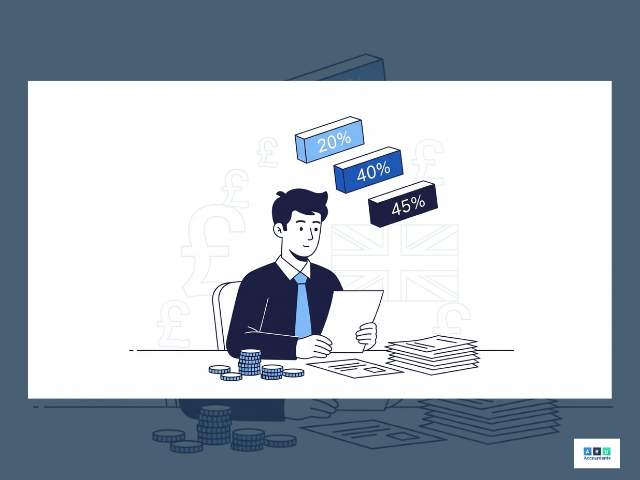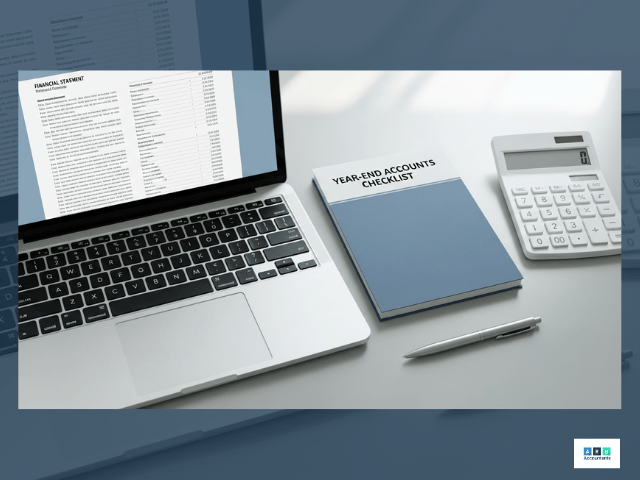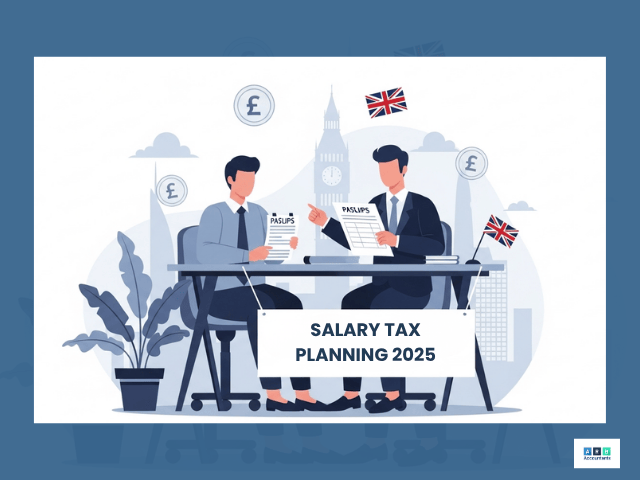
Salary vs Dividends: What Is the Best Way to Pay Yourself
The salary vs dividends decision can be one of the most important choices for UK company directors.
Pick the wrong approach and you could pay more tax than necessary or hurt your ability to secure finance. With paye vs dividends, salaries attract Income Tax and National Insurance, while Ltd company dividends are taxed differently and only from post-corporation tax profits.
If you’ve wondered how much dividends can I take or how much can I pay myself in dividends without hitting a higher tax rate, the answer depends on your income mix.
For example, £12,570 salary plus £37,700 in dividends from a limited company keeps most directors in the basic rate band (GOV.UK). But paying dividends from a limited company above this level could push you into higher rates of director dividends tax.
- Salary vs Dividends: What Are the Key Differences for UK Company Directors
- How Are Salary Payments Processed and Reported?
- How Much in Dividends Can a Director Take from a Limited Company?
- What Is the At-a-Glance Comparison Between Salary and Dividends?
- What Is the At-a-Glance Comparison Between Salary and Dividends?
- PAYE vs Dividends: How Are They Taxed in the UK?
- How Do Corporation Tax Rules Affect Dividend Payments?
- What Are the Current Dividend Tax Rates and Allowances in the UK?
- Do Dividends Count as Income in the UK?
- How Much Can I Pay Myself in Dividends Without Extra Tax?
- How Can Directors Combine Salary and Dividends Efficiently?
- What Is the Best Strategy for Timing Salary and Dividend Payments?
- What Happens If Dividends Push Me Above the Basic Rate Tax Band?
- Dividend Compliance: What Rules Must Limited Companies Follow?
- What Documentation and Records Are Required for Dividends?
- What Is a Dividend Voucher and Why Is It Needed?
- How Does HMRC Treat Illegal or Unlawful Dividends?
- How Do Compliance Rules Link Back to Tax Efficiency?
- Are Dividends Paid Before or After Corporation Tax?
- Self Assessment and Dividends: How Should Directors Report Dividend Income?
- Combining Salary and Dividends for Maximum Efficiency
- Why Do Many Directors Choose to Pay Themselves a Low Salary?
- How Much Can I Pay Myself in Dividends?
- How Do Pension Contributions Affect Salary vs Dividends in the Long Term?
- Salary vs Dividends: What’s the Best Option for Directors?
- Is It Better to Pay Yourself a Salary or Dividends?
- What Are the Most Common Mistakes Directors Make When Taking Dividends?
- What Future Changes Could Impact Salary vs Dividends Strategy in the UK?
- Frequently Asked Questions
Salary vs Dividends: What Are the Key Differences for UK Company Directors
When deciding between salary vs dividends, UK company directors need to understand not only how each is taxed, but also how they’re processed and reported. Under PAYE vs dividends, salaries are treated as employment income, subject to Income Tax and National Insurance (both employee and employer contributions), and must be reported via payroll each month. In contrast, dividends from a limited company are paid from post Corporation Tax profits and are not subject to National Insurance.
How Are Salary Payments Processed and Reported?
- Salary: Run through PAYE, reported to HMRC in real-time. Provides proof of regular income for mortgages and loans.
- Dividends: Declared by the board, recorded in minutes, and supported by a dividend voucher. Reported on your Self Assessment return.
How Much in Dividends Can a Director Take from a Limited Company?
There’s no statutory limit. To answer the question of how much can I pay myself in dividends depends on available post-tax profits. Paying more than your retained profits risks being classed as an illegal distribution, which can lead to HMRC penalties.
What Is the At-a-Glance Comparison Between Salary and Dividends?
| Aspect | Salary | Dividends |
|---|---|---|
| Tax | Income Tax + NI | Dividend Tax only |
| Timing | Monthly PAYE | When declared |
| Proof of income | Strong | Limited |
| Pension contributions | Yes | No (unless via salary) |
| Risk | Lower HMRC scrutiny | Must have sufficient profits |
Director dividends tax is currently 8.75% (basic), 33.75% (higher), 39.35% (additional) after a £500 dividend allowance (GOV.UK). Choosing between paying dividends from a limited company and a salary should align with both tax efficiency and personal financial goals.
What Is the At-a-Glance Comparison Between Salary and Dividends?
When comparing salary vs dividends for a UK limited company director, it’s important to understand that the two are taxed in entirely different ways. Salary is processed through PAYE, meaning Income Tax and National Insurance (NI) are deducted at source. For directors, this includes both employee and employer NI, which can significantly increase the overall cost to the company. Dividends, on the other hand, are paid from post–Corporation Tax profits and are not subject to NI, making them a popular choice for tax efficiency.
PAYE vs Dividends: How Are They Taxed in the UK?
Under PAYE vs dividends, any salary above personal allowance (£12,570 in 2025/26) is taxed at 20% (basic rate), 40% (higher rate), or 45% (additional rate), plus NI at 8% for employees (2% above the upper earnings limit) and 13.8% for employers. The upside of taking a salary is that it counts as qualifying income for pensions and can improve mortgage affordability.
How Do Corporation Tax Rules Affect Dividend Payments?
Before a limited company can pay dividends, it must pay Corporation Tax (currently 25% on profits exceeding £250,000). This means the question of how much dividends can I take depends entirely on retained post-tax profits. Taking more than this can result in an illegal distribution, which HMRC can reclaim.
READ RELATED ARTICLE: Do all businesses pay corporation tax?
What Are the Current Dividend Tax Rates and Allowances in the UK?
As of April 2025, the dividend allowance is £500. After this, director dividends tax applies at 8.75% (basic rate), 33.75% (higher rate), or 39.35% (additional rate) (GOV.UK). For example, if you take £40,000 in dividends from a limited company alongside a £12,570 salary, you’ll pay no NI on the dividends and benefit from lower overall tax than taking the same amount solely as salary.
Paying dividends from a limited company can reduce tax bills, but deciding how much can I pay myself in dividends requires balancing short-term savings with the benefits of a regular salary. For many, the most efficient approach is a mix, a modest salary for NI and pension purposes, and the remainder as dividends.
Do Dividends Count as Income in the UK?
Yes, dividends do count as income in the UK, but they are treated differently from salary for tax purposes. While salary is classed as “earned income” and taxed through PAYE with Income Tax and National Insurance, dividends are classed as “unearned income.” They don’t attract NIC, but they must be declared on your Self Assessment tax return. This distinction is crucial when applying for mortgages or loans, as some lenders treat dividend income differently from regular salary income.
How Much Can I Pay Myself in Dividends Without Extra Tax?
When weighing salary vs dividends, many UK directors ask, “How much dividends can I take without moving into a higher tax band?” The answer depends on both your personal allowance and the dividend allowance. For 2025/26, the personal allowance remains £12,570 (GOV.UK), while the dividend allowance is £500 (GOV.UK).
How Can Directors Combine Salary and Dividends Efficiently?
If you take a salary up to the personal allowance, you can add Ltd company dividends of up to £37,700 before entering the higher dividend tax rate. At this level, dividends are taxed at 8.75%, far lower than PAYE income tax for the same amount. This is why many directors opt for a modest salary plus dividends from a limited company.
Example:
- Salary: £12,570 (no Income Tax, minimal NI)
- Dividends: £37,700 (taxed at 8.75% after £500 allowance)
- Result: £50,270 total income at the lowest combined rates.
What Is the Best Strategy for Timing Salary and Dividend Payments?
Paying dividends from a limited company just before the tax year ends can help maximise allowances. Conversely, delaying until the next tax year can keep you in a lower band if income is expected to drop.
What Happens If Dividends Push Me Above the Basic Rate Tax Band?
Once total income exceeds £50,270, director’s dividends tax jumps to 33.75%. This is why careful planning is key when deciding how much can I pay myself in dividends. For some, staying within the lower band is best; for others, withdrawing more to meet personal expenses outweighs the extra tax.
Dividend Compliance: What Rules Must Limited Companies Follow?
When deciding between salary vs dividends, it’s essential to understand that paying dividends from a limited company is subject to strict legal requirements. Dividends can only be paid from distributable profits meaning profits after corporation tax has been accounted for (GOV.UK). If no such profits exist, any payment labelled a dividend could be considered “illegal” and may need to be repaid.
What Documentation and Records Are Required for Dividends?
For every dividend payment, directors must hold a board meeting to declare it, even if they are the only shareholders. You should prepare:
- Minutes of the meeting
These records protect you if HMRC questions whether the distribution was lawful.
What Is a Dividend Voucher and Why Is It Needed?
Whenever a limited company pays dividends, it must issue a dividend voucher. This document acts as proof of the payment and includes:
- Company name
- Date of payment
- Amount of the dividend
HMRC requires that dividend vouchers are retained with company records. Even if you are the only shareholder and director, you must still produce a dividend voucher each time you take a dividend. This helps demonstrate compliance if HMRC investigates whether payments were lawful and properly documented.
How Does HMRC Treat Illegal or Unlawful Dividends?
If you withdraw funds when no distributable profits are available, HMRC may classify it as a director’s loan instead of a dividend, potentially triggering extra tax liabilities. This can also affect your credit standing when applying for personal loans or mortgages.
READ RELATED ARTICLE: What can a director’s loan be used for?
How Do Compliance Rules Link Back to Tax Efficiency?
Knowing the compliance rules is crucial when planning how much dividends can I take or how much can I pay myself in dividends without breaking the law. Failure to follow the process can undermine any tax advantage in the paye vs dividends debate. Proper records help prove that dividends from a limited company were legitimate and correctly taxed under director dividends tax rules.
Are Dividends Paid Before or After Corporation Tax?
No, dividends are always paid after Corporation Tax has been accounted for. This means the company pays Corporation Tax on profits first, and only the remaining post-tax profits can be distributed as dividends. Paying dividends before Corporation Tax would be considered an illegal dividend, which HMRC can demand to be repaid. This is why accurate profit calculations and board approval are essential before declaring dividends.
Self Assessment and Dividends: How Should Directors Report Dividend Income?
If you’re a UK company director, any dividends you receive must be reported through your Self Assessment tax return. Even if your dividends fall within the £500 dividend allowance, HMRC still requires you to declare them.
Key points directors should know:
- Where to declare: Dividend income is entered in the “UK dividends” section of the Self Assessment form.
- Tax bands apply: Your dividend income is added to your salary and other earnings to determine your overall tax band.
- Deadlines: Online Self Assessment filing is usually due by 31 January following the tax year. Late submissions or missed dividend declarations can trigger penalties.
- Supporting records: Keep dividend vouchers and board meeting minutes as evidence in case HMRC requests proof.
Combining Salary and Dividends for Maximum Efficiency
When deciding between salary vs dividends, many company directors choose a low salary combined with ltd company dividends to maximise tax efficiency. Typically, directors pay themselves a salary just above the National Insurance threshold (around £12,570) to qualify for state benefits like the pension, without paying employee National Insurance Contributions.
Why Do Many Directors Choose to Pay Themselves a Low Salary?
- A low salary ensures NI credits for future state pension.
- It maintains eligibility for mortgages and loans, as lenders favour regular salary evidence.
- It reduces PAYE costs while fulfilling legal obligations.
How Much Can I Pay Myself in Dividends?
After a low salary, directors often ask, how much dividends can I take without paying high tax? The first £1,000 of dividends from a limited company is tax-free (dividend allowance). Above this:
- Basic rate: 8.75% tax on dividends
- Higher rate: 33.75%
- Additional rate: 39.35%
Careful planning of paying dividends from a limited company prevents unnecessary tax hikes.
How Do Pension Contributions Affect Salary vs Dividends in the Long Term?
Unlike salary, dividends do not count towards NI or pension qualifying years. So while dividends reduce tax, a minimal salary is necessary for state benefits. Directors can make personal pension contributions from dividends but won’t get NI credits this way.
Salary vs Dividends: What’s the Best Option for Directors?
Balancing PAYE salary and dividends helps minimise overall tax while preserving pension and loan access. Each company director should tailor the split based on income and future plans.
Is It Better to Pay Yourself a Salary or Dividends?
The answer depends on your priorities.
- Salary is better if you want consistent income proof, qualify for state pension credits, and make pension contributions.
- Dividends are often more tax efficient because they avoid NIC and are taxed at lower rates.
For most directors, a mix of the two is the most efficient approach: a modest salary (to cover NIC and pension eligibility) plus dividends for the remainder. However, the right split depends on your income level, company profits, and personal financial goals.
What Are the Most Common Mistakes Directors Make When Taking Dividends?
When deciding between salary vs dividends, many directors make mistakes that can cause tax and legal problems.
Drawing without profits is a major error. You can only pay limited company dividends from distributable profits, not just company cash. Taking dividends without enough profits is illegal and may lead to penalties or personal liability.
Another mistake is ignoring personal tax thresholds when figuring out how much dividends can I take. Dividend tax rates vary based on your income: 8.75% for basic rate, 33.75% for higher rate, and 39.35% for additional rate taxpayers (2023/24) source: GOV.UK. Without careful planning of salary and dividends, you risk higher director dividends tax bills.
Confusing company cash flow with distributable profits is common. Just because the company has money doesn’t mean you can withdraw it legally. Funds may be reserved for expenses or liabilities, so ensure your profits justify paying dividends from a limited company.
To avoid trouble, always confirm your company’s retained earnings before a limited company paying dividends, and consider your personal tax band when deciding how much can I pay myself in dividends.
What Future Changes Could Impact Salary vs Dividends Strategy in the UK?
When weighing salary vs dividends, company directors must stay alert to upcoming tax changes that could affect how much they take from their business. Recent government proposals hint at possible increases in director dividends tax and corporation tax rates, directly impacting paying dividends from a limited company.
Key points to consider:
- Dividend tax rate changes: The UK government has signaled potential rises in dividend tax bands. This means how much dividends can I take tax-efficiently may be reduced, influencing decisions on how much can I pay myself in dividends. Staying updated on these changes is critical to avoid unexpected tax liabilities.
- Corporation tax increases: As corporation tax rises, Ltd company dividends might shrink, affecting overall net profits available for distribution. This impacts the limited company paying dividends strategies and could tilt the balance between PAYE vs dividends.
- Reforms to allowances: The dividend allowance or personal allowance may also be reformed, which influences do I pay tax on dividends from my limited company and planning for dividends from a limited company.
To future-proof your income strategy, keep an eye on these evolving rules and adjust your salary vs dividends balance accordingly. As one of the trusted accountancy firms Southend businesses turn to, ARB helps you stay ahead with clear, practical tax strategies.






